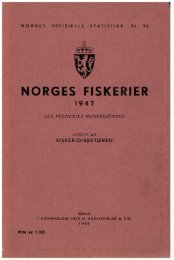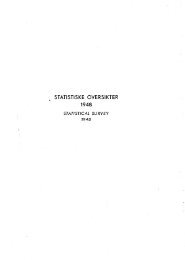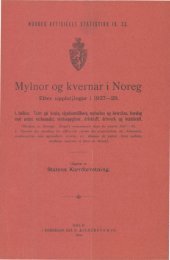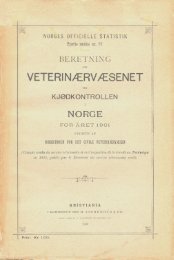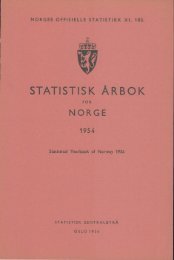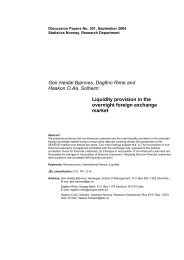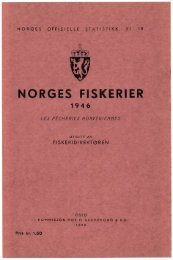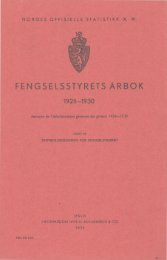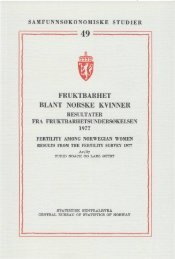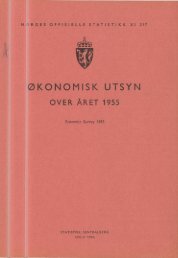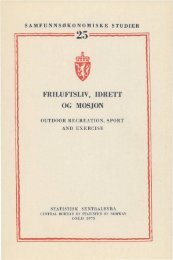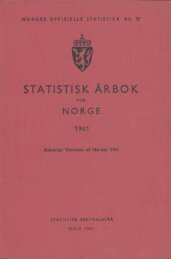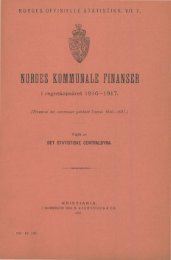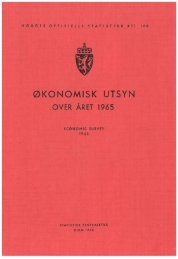Utenrikshandel 1995 - Statistisk sentralbyrå
Utenrikshandel 1995 - Statistisk sentralbyrå
Utenrikshandel 1995 - Statistisk sentralbyrå
Create successful ePaper yourself
Turn your PDF publications into a flip-book with our unique Google optimized e-Paper software.
<strong>Utenrikshandel</strong> <strong>1995</strong><br />
1. Purpose<br />
The purpose of the external trade statistics is to give information<br />
about the commodity flows between Norway<br />
and other countries. The statistics intend to meet the demands<br />
from industry or trade for data in their planning<br />
of production, sales and marketing activities. Furthermore,<br />
the statistics are needed for prognoses and analyses<br />
performed by public authorities, research institutions,<br />
private organisations etc. International organisations,<br />
like the UN's Statistical Office, make use of information<br />
from the external trade data, supplied by the<br />
individual countries. The statistics form integrating<br />
parts of the national and international statistical<br />
systems and are also utilised for the preparation of<br />
national accounts and balance of payment statistics.<br />
Accordingly, internationally adopted definitions as well<br />
as standards for commodity and country classifications<br />
are adhered to.<br />
2. Survey design<br />
2.1. Source material<br />
The external trade statistics are based on information<br />
collected by the Customs Authorities in conjunction<br />
with the declaration of imports and exports of goods.<br />
For the preparation of data, Statistics Norway receives<br />
copies of the Customs declarations (SAD forms) from<br />
the Customs, filled in by importers and exporters. Information<br />
on imports and exports of special equipment,<br />
i.e. ships, electric current and imports or exports falling<br />
outside the Customs' area, like equipment imported<br />
directly to the Norwegian part of the Continental Shelf<br />
or crude oil and natural gas, exported by pipeline from<br />
the shelf, are based on special reports. Complete figures<br />
for imports directly to the Norwegian part of the Continental<br />
Shelf are only available as estimates in the<br />
balance of payment statistics. The Norwegian Petroleum<br />
Directorate reports monthly the quantity of oil<br />
exported from the oil fields in the North Sea. The same<br />
authority also submits monthly reports on the quantities<br />
of gas exported by pipeline.<br />
2.2. Coverage<br />
The coverage of the statistics is mainly in accordance<br />
with the recommendations of the United Nations<br />
Statistical Commission and adheres to the general trade<br />
principle. The difference between the special trade and<br />
the general trade principles is the recording of goods<br />
passing through bonded warehouse's. Under the general<br />
trade principle direct imports are recorded at the time<br />
of customs clearance. Goods coming through bonded<br />
warehouses are recorded as imports when they enter<br />
these warehouses, and as exports when they are sold<br />
abroad from the warehouses. According to the special<br />
trade principle, however, imports are recorded in the<br />
statistics when the goods are cleared by the customs,<br />
Norges offisielle statistikk<br />
.1.111.011111.■■■1111MIMINIONI<br />
whereas re-exports from the warehouses would be<br />
excluded from the export statistics. The statistical area<br />
of Norway includes the Norwegian part of the Continental<br />
Shelf, Svalbard and Jan Mayen with Bjørnøya. Commodities<br />
with a statistical value less than 1 000 kroner<br />
are not included in the statistics.<br />
Import statistics thus comprise commodities cleared<br />
on arrival and commodities placed in customs bonded<br />
warehouses. Information about imports directly for permanent<br />
constructions on the Norwegian Continental<br />
Shelf are, however, not published in the external trade<br />
statistics. Estimates for these imports are instead included<br />
in the balance of the current account. Imports<br />
for use on the Continental Shelf, first cleared by the<br />
Customs at ports of entry, are recorded as other goods.<br />
Unstabilised crude oil is transported by pipeline from<br />
Norwegian area to the United Kingdom where it is processed<br />
into stabilised crude oil and NGL components.<br />
Partially these products are imported to Norway, and in<br />
the statistics recorded as imports from the United Kingdom.<br />
The following categories of imports are not included in<br />
the statistics:<br />
a) Direct transit trade<br />
b) The catch outside the territorial waters by fishing<br />
expeditions and fishing vessels under the<br />
Norwegian flag<br />
c) Returned merchandise (claims etc.) and returned<br />
packing material<br />
d) Indemnifications<br />
e) Merchandise for repair in Norway on foreign account<br />
f) Merchandise returned after repair abroad on<br />
Norwegian account<br />
g) Personal belongings; removable articles imported<br />
on transfer of residence<br />
h) Goods imported for the Crown and diplomatic corps<br />
i)j) Supplies under military defence agreements<br />
k) Commercial samples, advertising material, gifts etc.<br />
of negligible value<br />
1) Monetary gold<br />
m) Current coin; unused Norwegian postage, revenue<br />
and similar stamps of current or new issue; stampimpressed<br />
paper; banknotes, stock, share and bond<br />
certificates and similar documents of title; cheque<br />
books<br />
n) Bunkers<br />
o) Temporary importation of goods according to<br />
international conventions and recommendations<br />
(goods on loan, professional equipment, transport<br />
equipment, containers, pallets and packing<br />
materials, broadcasting and television equipment<br />
for use to transmit material abroad or to record<br />
material, goods for display or use at exhibitions,<br />
fairs, meetings and similar events, instruments and<br />
apparatus for scientific research, welfare material<br />
for seafarers).<br />
12



